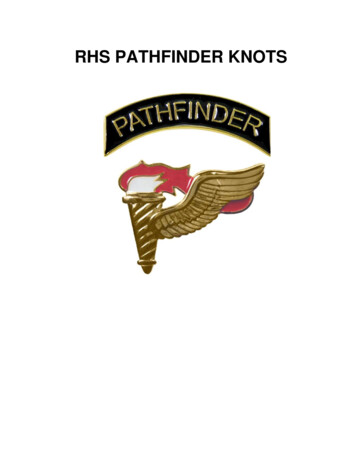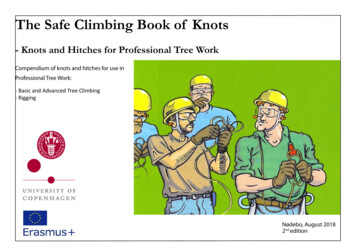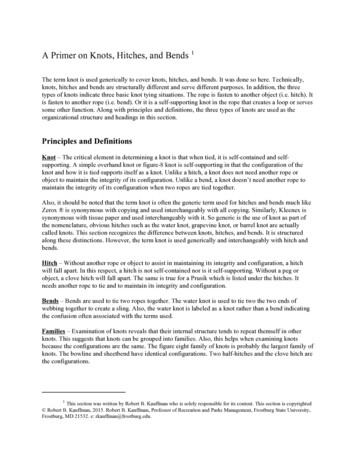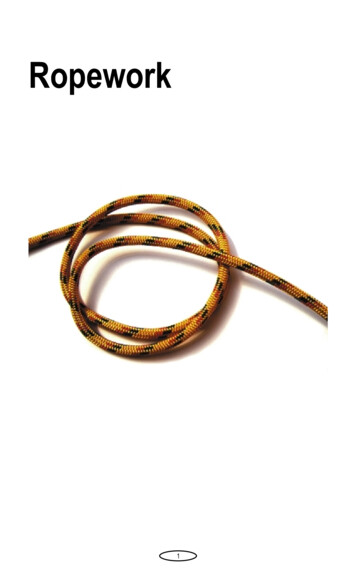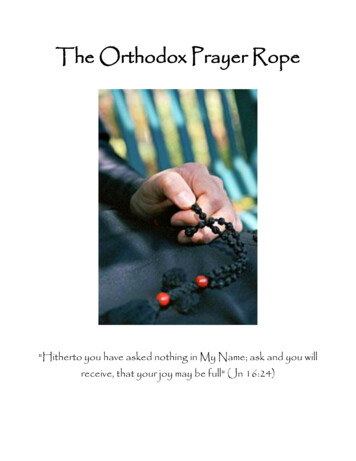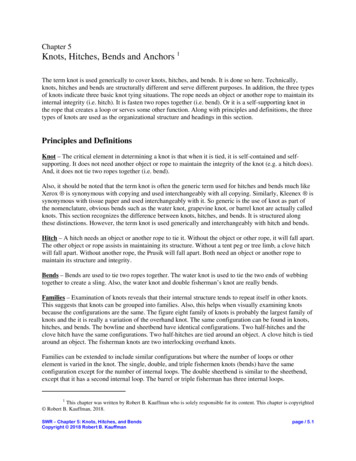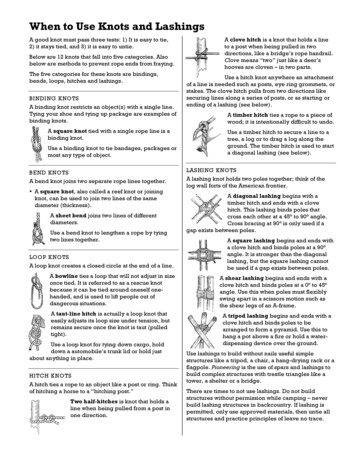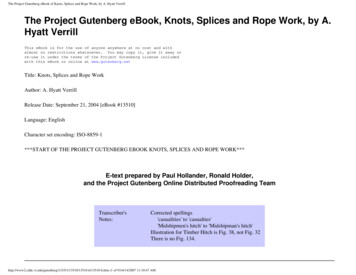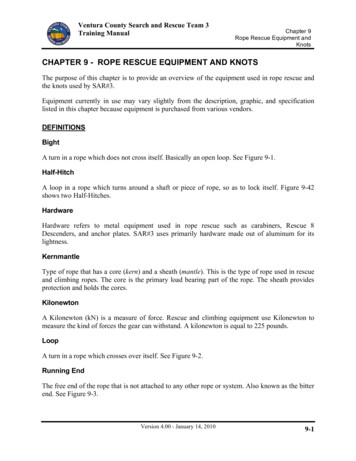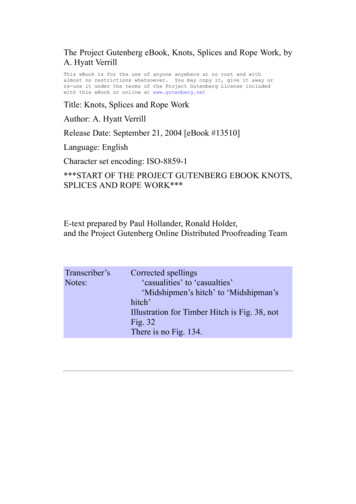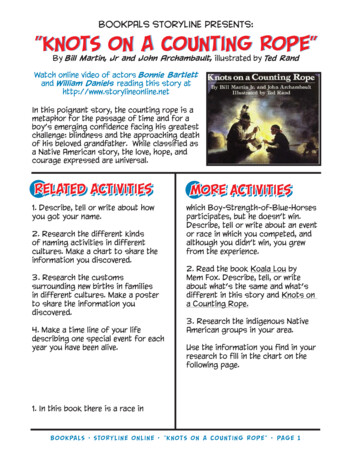
Transcription
FM ection I. Knots, Hitches, and LashingsA study of the terminology pictured in Figure2-1 and the definitions in Table 2-1, page 2-2,will aid in understanding the methods ofknotting presented in this section.Knots, Splices, Attachments, and Ladders 2-1
FM 5-125The raw, cut end of a rope has a tendency tountwist and should always be knotted or fastened in some manner to prevent thisuntwisting. Whipping is one method of fastening the end of the rope to preventuntwisting (see Figure 2-2). A rope iswhipped by wrapping the end tightly with asmall cord. This method is particularly satisfactory because there is very little increase inthe size of the rope. The whipped end of arope will still thread through blocks orother openings. Before cutting a rope, placetwo whippings on the rope 1 or 2 inchesapart and make the cut between the whippings (see Figure 2-2). This will prevent thecut ends from untwisting immediatelyafter they are cut.KNOTSused as a stopper to prevent a rope fromA knot is an interlacement of the partspassingthrough an opening.of one or more flexible bodies, such as cordage rope, forming a lump. It is also any tie orA good knot must be easy to tie, must holdfastening formed with a rope, includingwithout slipping, and must be easy tobends, hitches, and splices. A knot is oftenuntie. The choice of the best knot, bend, or2-2 Knots, Splices, Attachments, and Ladders
FM 5-125Knots, Splices, Attachments, and Ladders 2-3
FM 5-125hitch to use depends largely on the job ithas to do. In general, knots can be classified into three groups. They are—Knots at the end of a rope.Knots for joining two ropes.Knots for making loops.KNOTS AT THE END OF ROPEKnots at the end of a rope fall into the following categories:Overhand knot.Figure-eight knot.Wall knot.Overhand KnotThe overhand knot is the most commonlyused and the simplest of all knots (see Figure 2-3). Use an overhand knot to prevent2-4 Knots, Splices, Attachments, and Laddersthe end of a rope from untwisting, to form aknob at the end of a rope, or to serve as apart of another knot. When tied at the endor standing part of a rope, this knot preventsit from sliding through a block, hole, oranother knot. Use it also to increase a person’s grip on a rope. This knot reduces thestrength of a straight rope by 55 percent.Figure-Eight KnotUse the figure-eight knot to form a largerknot at the end of a rope than would beformed by an overhand knot (see Figure2-4). The knot prevents the end of the ropefrom slipping through a fastening or loop inanother rope or from unreeving when reevedthrough blocks. It is easy to untie.Wall KnotUse the wall knot with crown to preventthe end of a rope from untwisting when an
FM 5-125enlarged end is not objectionable (see Figure2-5). The wall knot also makes a desirableknot to prevent the end of the rope from slipping through small openings, as when usingrope handles on boxes. Use either the crownor the wall knot separately to form semipermanent "stopper knots" tied with the endstrands of a rope. The wall knot will preventthe rope from untwisting, but to make aneat round knob, crown it (see Figure 2-6,page 2-6). Notice that in the wall knot, theends come up through the bights, causingthe strands to lead forward. In a crownknot, the ends go down through the bightsand point backward.KNOTS FOR JOINING TWO ROPESKnots for joining two ropes fall into the following categories:Square knot.Single sheet bend.Double sheet bend.Carrick bend.Square KnotUse the square knot to tie two ropes ofequal size together so they will not slip (seeKnots, Splices, Attachments, and Ladders 2-5
FM 5-125Figure 2-7). Note that in the square knot,the end and standing part of one rope comeout on the same side of the bight formed bythe other rope. The square knot will nothold if the ropes are wet or if they are of different sizes. It tightens under strain butcan be untied by grasping the ends of thetwo bights and pulling the knot apart.NOTE. It makes no differencewhether the first crossing is tiedleft-over-right or right-over-left aslong as the second crossing is tiedopposite to the first crossing.Single Sheet BendA single sheet bend, sometimes called aweaver’s knot, has two major uses (see Figure 2-8). They are—Tying together two ropes of unequalsize.Tying a rope to an eye.This knot will draw tight but will loosen orslip when the lines are slackened. The single sheet bend is stronger and unties easierthan the square knot.Double Sheet BendThe double sheet bend has greater holdingpower than the single sheet bend for joiningropes of equal or unequal diameter, joiningwet ropes, or tying a rope to an eye (see Figure 2-9, page 2-8,). It will not slip or drawtight under heavy loads. This knot is moresecure than the single sheet bend when usedin a spliced eye.Carrick BendUse the carrick bend for heavy loads and forjoining large hawsers or heavy rope (see Figure 2-10, page 2-8). It will not draw tightunder a heavy load and can be untied easilyif the ends are seized to their own standingpart.KNOTS FOR MAKING LOOPSKnots for making loops fall into the following categories:2-6 Knots, Splices, Attachments, and LaddersBowline.Double bowline.Running bowline.
FM 5-125Knots, Splices, Attachments, and Ladders 2-7
FM 5-1252-8 Knots, Splices, Attachments, and Ladders
FM 5-125Bowline on a bight.ing two loops support his legs. A notchedboard that passes through the two loopsmakes a comfortable seat known as a boatswain’s chair. This chair is discussed in thescaffolding section of this manual (see Chapter 6).Spanish bowline.French bowline.Speir knot.Cat’s-paw.Figure eight with an extra turn.BowlineThe bowline is one of the most commonknots and has a variety of uses, one of whichis the lowering of men and material (see Figure 2-11). It is the best knot for forming asingle loop that will not tighten or slip understrain and can be untied easily if each running end is seized to its own standing part.The bowline forms a loop that may be of anylength.Double BowlineThe double bowline forms three nonslippingloops (see Figure 2-12, page 2-10). Use thisknot to sling a man. As he sits in the slings,one loop supports his back and the remain-Running BowlineThe running bowline forms a strong runningloop (see Figure 2-13, page 2-10). It is a convenient form of running an eye. The running bowline provides a sling of the chokertype at the end of a single line. Use it whentying a handline around an object at a pointthat you cannot safely reach, such as the endof a limb.Bowline on a BightThis knot forms two nonslipping loops (seeFigure 2-14, page 2-11). You can use thebowline on a bight for the same purpose as aboatswain’s chair. It does not leave bothhands free, but its twin nonslipping loopsform a comfortable seat. Use it when—You need more strength than a singlebowline will give.Knots, Splices, Attachments, and Ladders 2-9
FM 5-1252-10 Knots, Splices, Attachments, and Ladders
FM 5-125You need to form a loop at some pointin a rope other than at the end.You do not have access to the end of arope.You can easily untie the bowline on a bightand tie it at the end of a rope by doublingthe rope for a short section.Spanish BowlineYou can tie a Spanish bowline at any pointin a rope, either at a place where the line isdouble or at an end that has been doubledback (see Figure 2-15, page 2-12). Use theSpanish bowline in rescue work or to give atwofold grip for lifting a pipe or other roundobjects in a sling.French BowlineYou can use the French bowline as a sling tolift injured men (see Figure 2-16, page 2-12).When used for this purpose, one loop is aseat and the other loop is put around thebody under the arms. The injured man’sweight keeps the two loops tight so that hecannot fall out. It is particularly useful as asling for an unconscious man. Also, use theFrench bowline when working alone and youKnots, Splices, Attachments, and Ladders 2-11
FM 5-125need your hands free. The two loops of thisknot can be adjusted to the size required.a one-rope bridge across a small stream.You can tie and untie it easily.Speir KnotUse a speir knot when you need a fixed loop,a nonslip knot, and a quick release (see Figure 2-17). You can tie this knot quickly andrelease it by pulling on the running end.KNOTS FOR TIGHTENING A ROPEThe types of knots used for tightening a ropeare the butterfly knot and the baker bowline.Cat’s-pawUse a cat’s-paw to fasten an endless sling toa hook, or make it at the end of a rope to fasten the rope to a hook (see Figure 2-18). Youcan tie or untie it easily. This knot, which isreally a form of a hitch, is a more satisfactoryway of attaching a rope to a hook than theblackwall hitch. It will not slip off and neednot be kept taut to make it hold.Butterfly KnotUse the butterfly knot is to pull taut a highline, handline, tread rope for foot bridges, orsimilar installations (see Figure 2-20, page2-14). Using this knot provides the capability to tighten a fixed rope when mechanicalmeans are not available. (You can also usethe harness hitch for this purpose [see Figure 2-32, page 2-22]). The butterfly knot willnot jam if a stick is placed between the twoupper loops.Figure Eight With an Extra TurnUse a figure eight with an extra turn totighten a rope (see Figure 2-19, page 2-14).This knot is especially suitable for tighteningBaker BowlineYou can use the baker bowline for the samepurpose as the butterfly knot and for lashingcargo (see Figure 2-21, pages 2-15 and 2-16).2-12 Knots, Splices, Attachments, and Ladders
FM 5-125When used to lash cargo, secure one endwith two half hitches, pass the rope over thecargo and tie a baker bowline, then securethe lashing with a slippery half hitch. Torelease the rope, simply pull on the runningend. Advantages of the baker bowline arethat it can be—Tied easily.Adjusted without losing control.Released quickly.KNOTS FOR WIRE ROPEUnder special circumstances, when wirerope fittings are not available and it is necessary to fasten wire rope by some othermanner, you can use certain knots. In allknots made with wire rope, fasten therunning end of the rope to the standingpart after tying the knot. When wire-ropeclips are available, use them to fasten therunning end. If clips are not available, useKnots, Splices, Attachments, and Ladders 2-13
FM 5-1252-14 Knots, Splices, Attachments, and Ladders
FM 5-125Knots, Splices, Attachments, and Ladders 2-15
FM 5-1252-16 Knots, Splices, Attachments, and Ladders
FM 5-125wire or strands of cordage. Check all knotsin wire rope periodically for wear or signs ofbreakage. If there is any reason to believethat the knot has been subjected to exces-sive wear, cut off a short length of the endof the rope, including the knot, and tie anew knot. Use the fisherman’s bend, clovehitch, and carrick bend to fasten wire rope.HITCHESA hitch is any of various knots used to forma temporary noose in a rope or to secure arope around a timber, pipe, or post so thatit will hold temporarily but can be readilyundone. The types of hitches are as follows:Half hitch.Two half hitches.Round turn and two half hitches.Timber hitch.Timber hitch and half hitch.Clove hitch.Rolling hitch.Telegraph hitch.Mooring hitch.Scaffold hitch.Blackwall hitch.Harness hitch.Girth hitch.Sheepshank.Fisherman’s bend.HALF HITCHUse the half hitch to tie a rope to a timberor to a larger rope (see Figure 2-22, A). Itwill hold against a steady pull on thestanding part of the rope; however, it is nota secure hitch. You can use the half hitchto secure the free end of a rope and as anaid to and the foundation of many knots.For example, it is the start of a timberhitch and a part of the fisherman’s knot. Italso makes the rolling hitch more secure.TWO HALF HITCHESTwo half hitches are especially useful forsecuring the running end of a rope to thestanding part (see Figure 2-22, B). If thetwo hitches are slid together along thestanding part to form a single knot, theknot becomes a clove hitch.Knots, Splices, Attachments, and Ladders 2-17
FM 5-125ROUND TURN AND TWO HALF HITCHESAnother hitch used to fasten a rope to apole, timber, or spar is the round turn andtwo half hitches (see Figure 2-23). Forgreater security, seize the running end ofthe rope to the standing part. This hitchdoes not jam.TIMBER HITCHUse the timber hitch to move heavy timberor poles (see Figure 2-24). It is excellent forsecuring a piece of lumber or similarobjects. The pressure of the coils, one overthe other, holds the timber securely; themore tension applied, the tighter the hitchbecomes about the timber. It will not slipbut will readily loosen when the strain isrelieved.TIMBER HITCH AND HALF HITCHA timber hitch and half hitch are combinedto hold heavy timber or poles when they arebeing lifted or dragged (see Figure 2-25). Atimber hitch used alone may become untiedwhen the rope is slack or when a suddenstrain is put on it.CLOVE HITCHThe clove hitch is one of the most widelyused knots (see Figure 2-26, page 2-19). Youcan use it to fasten a rope to a timber, pipe,or post. You can also use it to make otherknots. This knot puts very little strain onthe fibers when the rope is put around anobject in one continuous direction. You cantie a clove hitch at any point in a rope. Ifthere is not constant tension on the rope,another loop (round of the rope around theobject and under the center of the clovehitch) will permit a tightening and slackening motion of the rope.ROLLING HITCHUse the rolling hitch to secure a rope toanother rope or to fasten it to a pole or pipe2-18 Knots, Splices, Attachments, and Ladders
FM 5-125so that the rope will not slip (see Figure2-27, page 2-20). This knot grips tightly butis easily moved along a rope or pole whenthe strain is relieved.TELEGRAPH HITCHThe telegraph hitch is a very useful andsecure hitch that you can use to hoist or haulposts and poles (see Figure 2-28, page 2-20).It is easy to tie and untie and will not slip.MOORING HITCHUse the mooring hitch, also called rolling ormagnus hitch, to fasten a rope around amooring post or to attach a rope at a rightangle to a post (see Figure 2-29, page 2-21).This hitch grips tightly and is easilyremoved.SCAFFOLD HITCHUse the scaffold hitch to support the end of ascaffold plank with a single rope (see Figure2-30, page 2-21). It prevents the plank fromtilting.BLACKWALL HITCHUse the blackwall hitch to fasten a rope to ahook (see Figure 2-31, page 2-22). Generally, use it to attach a rope, temporarily, to ahook or similar object in derrick work. Thehitch holds only when subjected to a constant strain or when used in the middle of aKnots, Splices, Attachments, and Ladders 2-19
FM 5-1252-20 Knots, Splices, Attachments, and Ladders
FM 5-125Knots, Splices, Attachments, and Ladders 2-21
FM 5-125rope with both ends secured. Human lifeand breakable equipment should never beentrusted to the blackwall hitch.The hitch is tied only in the middle of a rope.It will slip if only one end of the rope ispulled.HARNESS HITCHThe harness hitch forms a nonslipping loopin a rope (see Figure 2-32). It is oftenemployed by putting an arm through theloop, then placing the loop on the shoulderand pulling the object attached to the rope.GIRTH HITCHUse the girth hitch to tie suspender ropes tohand ropes when constructing expedient footbridges (see Figure 2-33). It is a simple andconvenient hitch for many other uses ofropes and cords.2-22 Knots, Splices, Attachments, and Ladders
FM 5-125SHEEPSHANKA sheepshank is a method of shortening arope, but you can use it to take the load off aweak spot in the rope (see Figure 2-34). It isonly a temporary knot unless the eyes arefastened to the standing part on each end.FISHERMAN’S BENDThe fisherman’s bend is an excellent knot forattaching a rope to a light anchor, a ring,or a rectangular piece of stone (see Figure 235, page 2-24). You can use it to fasten arope or cable to a ring or post. Also use itwhere there will be a slackening and tightening motion in the rope.Knots, Splices, Attachments, and Ladders 2-23
FM 5-125LASHINGSA lashing is as rope, wire, or chain used forbinding, wrapping, or fastening. The typesof lashings include square, shears, andblock.SQUARE LASHINGUse the square lashing to lash two sparstogether at right angles to each other (seeFigure 2-36). To tie a square lashing, beginwith a clove hitch on one spar and make aminimum of four complete turns aroundboth members. Continue with two frappingturns between the vertical and the horizontal spar to tighten the lashing. Tie off therunning end to the opposite spar fromwhich you started with another clove hitchto finish the square lashing.SHEARS LASHINGUse the shears lashing to lash two sparstogether at one end to form an expedientdevice called a shears (see Figure 2-37). Dothis by laying two spars side by side,spaced about one-third of the diameter of aspar apart, with the butt ends together.Start the shears lashing a short distance infrom the top of one of the spars by tying theend of the rope to it with a clove hitch.Then make eight tight turns around bothspars above the clove hitch. Tighten thelashing with a minimum of two frappingturns around the eight turns. Finish theshears lashing by tying the end of the ropeto the opposite spar from which you startedwith another clove hitch.2-24 Knots, Splices, Attachments, and Ladders
FM 5-125Knots, Splices, Attachments, and Ladders 2-25
FM 5-125BLOCK LASHINGUse the block lashing to tie a tackle block toa spar (see Figure 2-38). First, make threeright turns of the rope around the sparwhere the tackle block is to be attached.Pass the next two turns of the rope throughthe mouth of the hook or shackle of thetackle block and drawn tightly. Then putthree additional taut turns of the ropearound the spar above the hook or shackle.Complete the block lashing by tying the twoends of the rope together with a squareknot. When a sling is supported by a blocklashing, pass the sling through the centerfour turns.Section II. SplicesSplicing is a method of joining fiber or wirerope by unlaying strands of both ends andinterweaving these strands together. Thegeneral types of splices are—A short splice.The methods of making all four types ofsplices are similar. They generally consistof the following basic steps—Unlaying the strands of the rope.Placing the rope ends together.An eye or side splice.A long splice.Interweaving the strands and tuckingthem into the rope.A crown or back splice.FIBER-ROPE SPLICESWhen one strand of a rope is broken, youcannot repair it by tying the ends togetherbecause this would shorten the strand.Repair it by inserting a strand longer thanthe break and tying the ends together (seeFigure 2-39).short splice because a minimum reductionin rope length takes place in making thesplice. This splice is frequently used torepair damaged ropes when two ropes of thesame size are to be joined together permanently. Cut out the damaged parts of therope and splice the sound sections.SHORT SPLICEThe short splice is as strong as the rope inwhich it is made and will hold as much as along splice (see Figure 2-40). However, theshort splice causes an increase in the diameter of the rope for a short distance and canbe used only where this increase in diameterwill not affect operations. It is called theEYE OR SIDE SPLICEUse the eye or side splice to make a permanent loop in the end of a rope (see Figure2-41, page 2-28). You can use the loops,made with or without a thimble, to fastenthe rope to a ring or hook. Use a thimbleto reduce wear. Use this splice also to splice2-26 Knots, Splices, Attachments, and Ladders
FM 5-125Knots, Splices, Attachments, and Ladders 2-27
FM 5-125one rope into the side of another. As a permanent loop or eye, no knot can comparewith this splice for neatness and efficiency.The ropes to be joined should be the samelay and as nearly the same diameter aspossible.LONG SPLICEUse the long splice when the larger diameterof the short splice has an adverse effect onthe use of the rope; use it also to splice longropes that operate under heavy stress (seeFigure 2-42). This splice is as strong as therope itself. A skillfully made long splice willrun through sheaves without any difficulty.CROWN OR BACK SPLICEWhen you are splicing the end of a rope toprevent unlaying, and a slight enlargement of the end is not objectionable, use acrown splice to do this (see Figure 2-43,page 2-30). Do not put any length of ropeinto service without properly preparing theends.2-28 Knots, Splices, Attachments, and Ladders
FM 5-125Knots, Splices, Attachments, and Ladders 2-29
FM 5-1252-30 Knots, Splices, Attachments, and Ladders
FM 5-125WIRE-ROPEIn splicing wire rope, it is extremely important to use great care in laying the variousrope strands firmly into position. Slackstrands will not receive their full share of theload, which causes excessive stress to be puton the other strands. The unequal stressdistribution will decrease the possible ultimate strength of the splice. When usingsplices in places where their failure mayresult in material damage or may endangerhuman lives, test the splices under stressesequal to at least twice their maximum working load before placing the ropes into service.Table 2-2 shows the amount or length of ropeto be unlaid on each of the two ends of theropes and the amount of tuck for ropes of different diameters. As a rule of thumb, usethe following:Long splice, 40 times the diameter.Short splice, 20 times the diameter.You need only a few tools to splice wire rope.In addition to the tools shown in Figure 2-44,page 2-32, a hammer and cold chisel areoften used to cut the ends of strands. Usetwo slings of marline and two sticks toSPLICESuntwist the wire. A pocket knife may beneeded to cut the hemp core.SHORT SPLICEA short splice develops only from 70 to 90percent of the strength of the rope. Since ashort splice is bulky, it is used only for blockstraps, slings, or where an enlargement ofthe diameter is of no importance. It is notsuitable for splicing driving ropes or ropesused in running tackles and should neverbe put into a crane or hoist rope. The wirerope splice differs from the fiber ropeshort splice only in the method by which theend strands are tucked (see Figure 2-45,page 2-32).EYE OR SIDE SPLICEAn eye splice can be made with or without athimble. Use a thimble for every rope eyeunless special circumstances prohibit it (seeFigure 2-46, page 2-33). The thimble protects the rope from sharp bends and abrasive action. The efficiency of a well-madeeye splice with a heavy-duty thimble variesKnots, Splices, Attachments, and Ladders 2-31
FM 5-125from 70 to 90 percent. Occasionally, it becomes necessary to construct a field expedient, called a hasty eye (see Figure 2-47).The hasty eye can be easily and quicklymade but is limited to about 70 percent ofthe strength of the rope; consequently, itshould not be used to hoist loads.LONG SPLICEUse the long splice to join two ropes or tomake an endless sling without increasingthe thickness of the wire rope at the splice(see Figure 2-48, page 2-34). It is the bestand most important kind of splice because itis strong and trim.Round-Strand, Regular-Lay RopeThe directions given in Figure 2-48 are formaking a 30-foot splice in a three-fourths2-32 Knots, Splices, Attachments, and Ladders
FM 5-125Knots, Splices, Attachments, and Ladders 2-33
FM 5-125inch regular-lay, round-strand, hemp-centerwire rope. Other strand combinations differonly when there is an uneven number ofstrands. In splicing ropes having an oddnumber of strands, make the odd tuck at thecenter of the splice.Round-Strand, Lang-Lay RopeIn splicing a round-strand, Lang-lay rope, itis advisable to make a slightly longer splicethan for the same size rope of regular laybecause of the tendency of the rope tountwist. Up to the point of tucking theends, follow the procedure for regular lay.Then, instead of laying the strands side byside where they pass each other, crossthem over to increase the holding power ofthe splice. At the point where they cross,untwist the strands for a length of about 3inches so they cross over each other without materially increasing the diameter ofthe rope. Then finish the tucks in theusual manner.Section III. AttachmentsMost of the attachments used with wire ropeare designed to provide an eye on the end ofthe rope by which maximum strength can beobtained when the rope is connected withanother rope, hook, or ring. Figure 2-49 showsa number of attachments used with the eyesplice. Any two of the ends can be joinedtogether, either directly or with the aid of ashackle or end fitting. These attachmentsfor wire rope take the place of knots.2-34 Knots, Splices, Attachments, and Ladders
FM 5-125END FITTINGSAn end fitting may be placed directly on wirerope. Fittings that are easily and quicklychanged are clips, clamps, and wedge sockets.CLIPSWire-rope clips are reliable and durable (seeFigure 2-50, page 2-36). Use them, repeatedly, to make eyes in wire rope, either for asimple eye or an eye reinforced with a thimble, or to secure a wire-rope line or anchor-age to another wire rope. Table 2-3, page 236 shows the number-and spacing of clipsand the proper torque to apply to the nuts ofthe clips. After installing all the clips,tighten the clip farthest from the eye (thimble) with a torque wrench. Next, place therope under tension and tighten the clip nextto the clip you tightened first. Tighten theremaining clips in order, moving toward theloop (thimble). After placing the rope inservice, tighten the clips again immediatelyKnots, Splices, Attachments, and Ladders 2-35
FM 5-1252-36 Knots, Splices, Attachments, and Ladders
FM 5-125after applying the working load and at frequent intervals thereafter. Retightening isnecessary to compensate for the decrease inrope diameter that occurs when the strandsadjust to the lengthwise strain caused by theload. Position the clips so that they areimmediately accessible for inspection andmaintenance.CLAMPSA wire clamp can be used with or without athimble to make an eye in wire rope (see Figure 2-51). Ordinarily, use a clamp to makean eye without a thimble. It has about 90percent of the strength of the rope. Tightenthe two end collars with wrenches to forcethe clamp to a good snug fit. This crushesthe pieces of rope firmly against each other.WEDGE SOCKETUse a wedge-socket end fitting when it is tapered socket. The loop of wire rope mustnecessary to change the fitting at frequent be inserted in the wedge socket so that theintervals (see Figure 2-52, page 2-38). The standing part of the wire rope will form aefficiency is about two-thirds of the strength nearly direct line to the clevis pin of the fitof the rope. It is made in two parts. The ting. A properly installed wedge-socketsocket itself has a tapered opening for the connection will tighten when a strain iswire rope and a small wedge to go into this placed on the wire rope.BASKET-SOCKET END FITTINGThe basket-socket end fittings include closed its strength is sharply reduced and must besockets, open sockets, and bridge sockets considered to be about one-sixth the(see Figure 2-53, page 2-38). This socket is strength of a zinc connection. In all cases,ordinarily attached to the end of the rope the wire rope should lead from the socket inwith molten zinc or babbitt metal and is a line with the axis of the socket.permanent end rifting. If this fitting is properly made up, it is as strong as the ropePOURED METHODitself. If molten lead is used instead of zinc,the strength of the connection must be The poured basket socket is the most satisassumed to be reduced to one-fourth the factory method in use (see Figure 2-54, pagestrength of a zinc connection. The socket can 2-39). If the socketing is properly done, abe made up by the dry method if facilities are wire rope, when tested to destruction, willnot available to make a poured fitting, but break before it will pull out from the socket.Knots, Splices, Attachments, and Ladders 2-37
FM 5-1252-38 Knots, Splices, Attachments, and Ladders
FM 5-125Knots, Splices, Attachments, and Ladders 2-39
FM 5-125DRY METHODThe dry method should be used only whenfacilities are not available for the pouredmethod (see Figure 2-55). The strength ofthe connection must be assumed to bereduced to about one-sixth of the strengthof a poured zinc connection.STANCHIONSThe standard pipe stanchion is made up of al-inch diameter pipe (see Figure 2-56). Eachstanchion is 40 inches long. Two 3/4-inchwire-rope clips are fastened through holes inthe pipe with the centers of the clips 36inches apart. Use this stanchion, withoutmodifying it, for a suspended walkwaythat uses two wire ropes on each side.However, for handlines, remove or leaveoff the lower wire-rope clip. For more information on types and uses of stanchions,see TM 5-270.2-40 Knots, Splices, Attachments, and Ladders
FM 5-125Section IV. Rope LaddersRopes may be used in the construction ofhanging ladders and standoff ladders.HANGING LADDERSHanging ladders are made of wire or fiberrope anchored at the top and suspended vertically. They are difficult to ascend anddescend, particularly for a man carrying apack or load and should be used only whennecessary. The uprights of hanging laddersmay be made of wire or fiber rope andanchored at the top and bottom.WIRE-ROPE LADDERSWire-rope uprights with pipe rungs makethe most satisfactory hanging ladders because they are more rigid and do not sag asmuch as hanging ladders made of othermaterial. Wire-rope uprights with wire-roperungs are usable.Knots, Splices, Attachments, and Ladders 2-41
FM 5-125Wire-Rope Ladder With Pipe RungsMake a wire-rope ladder using either l-inchor 3/4-inch pipe rungs. The l-inch piperungs are more satisfactory. For such ladders, use the standard pipe stanchion.Space the pipe stanchions 12 inches apart inthe ladder and insert the 3/
KNOTS FOR WIRE ROPE Under special circumstances, when wire-rope fittings are not available and it is nec-essary to fasten w
